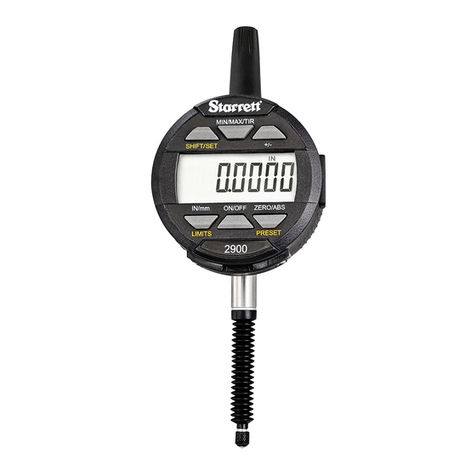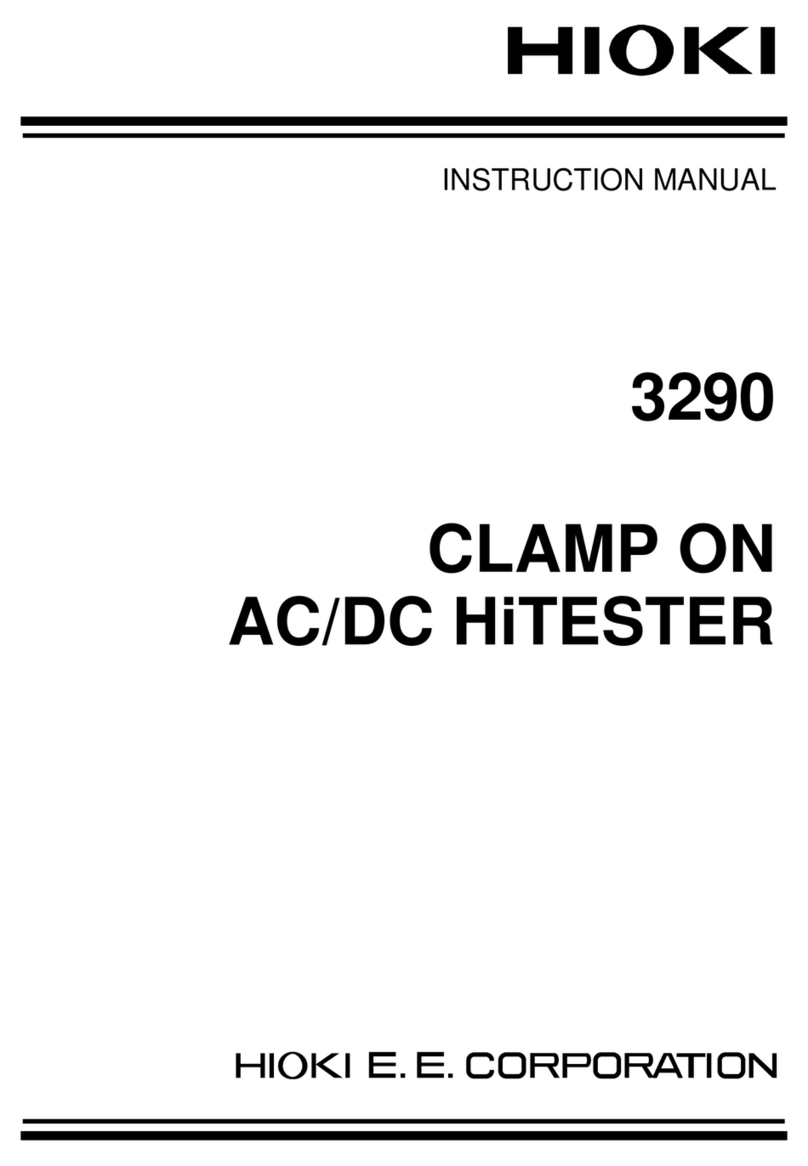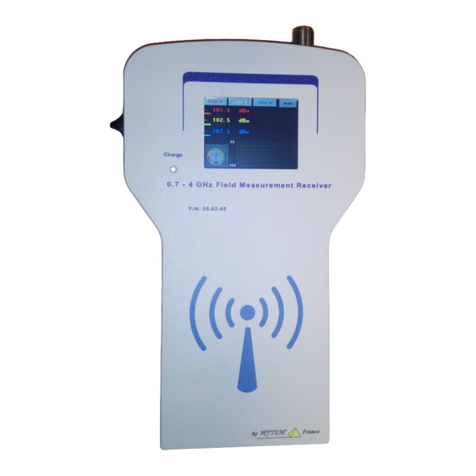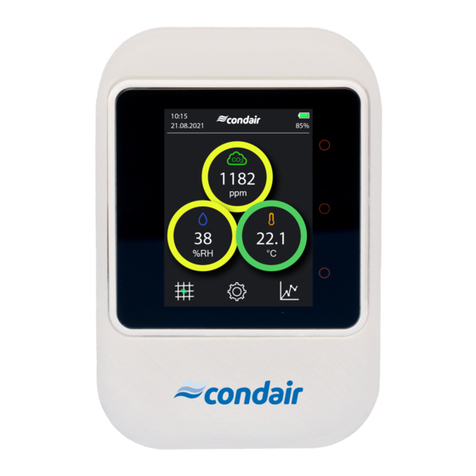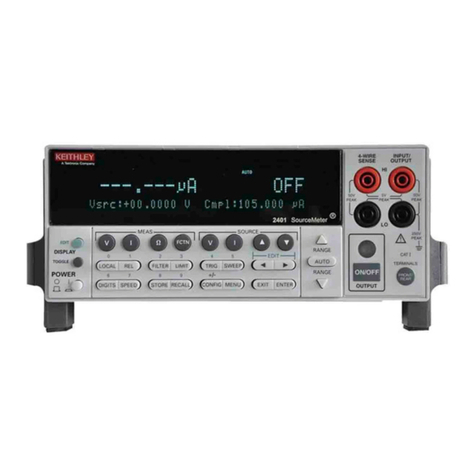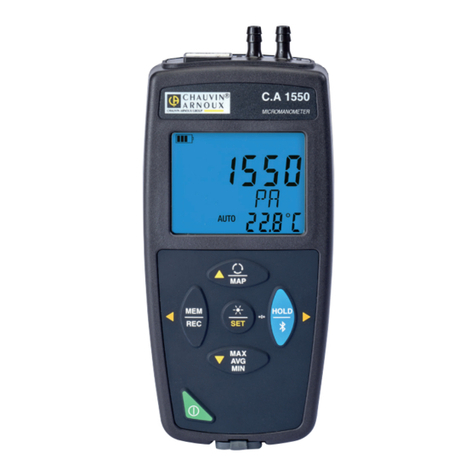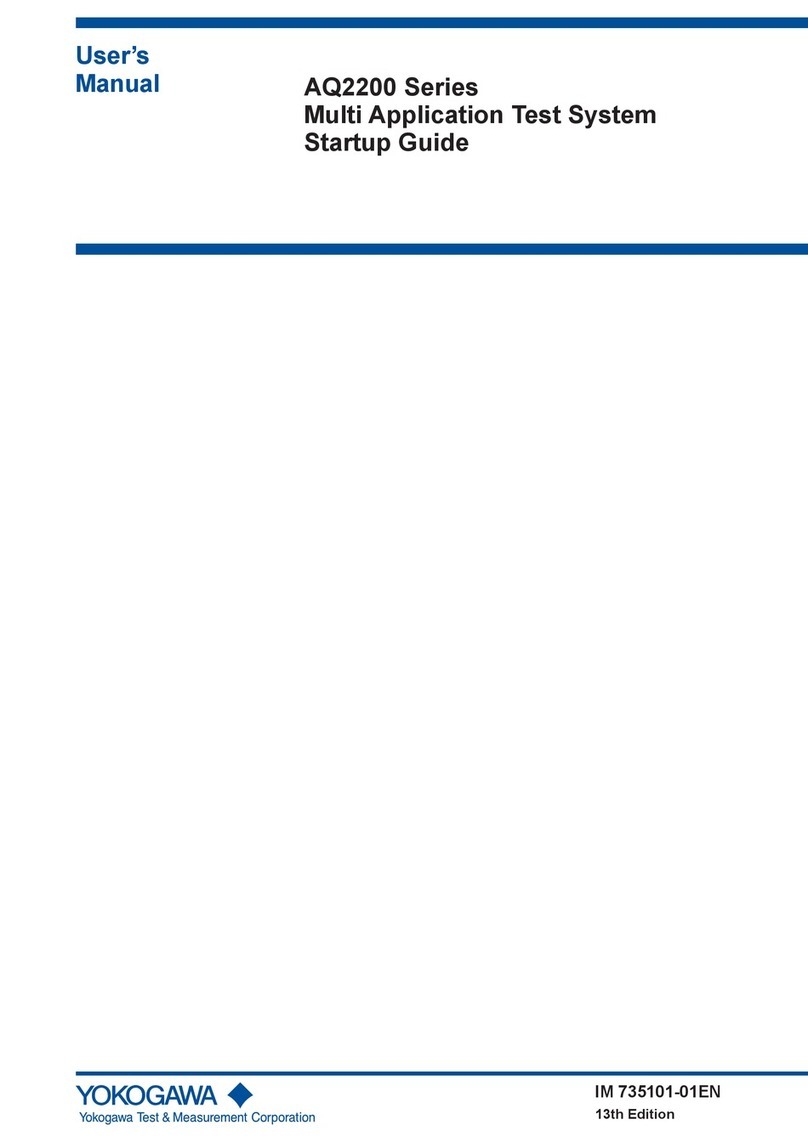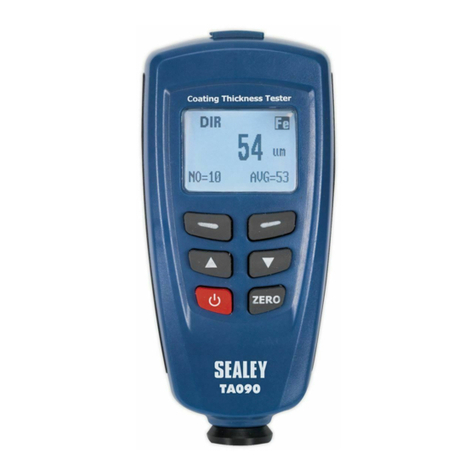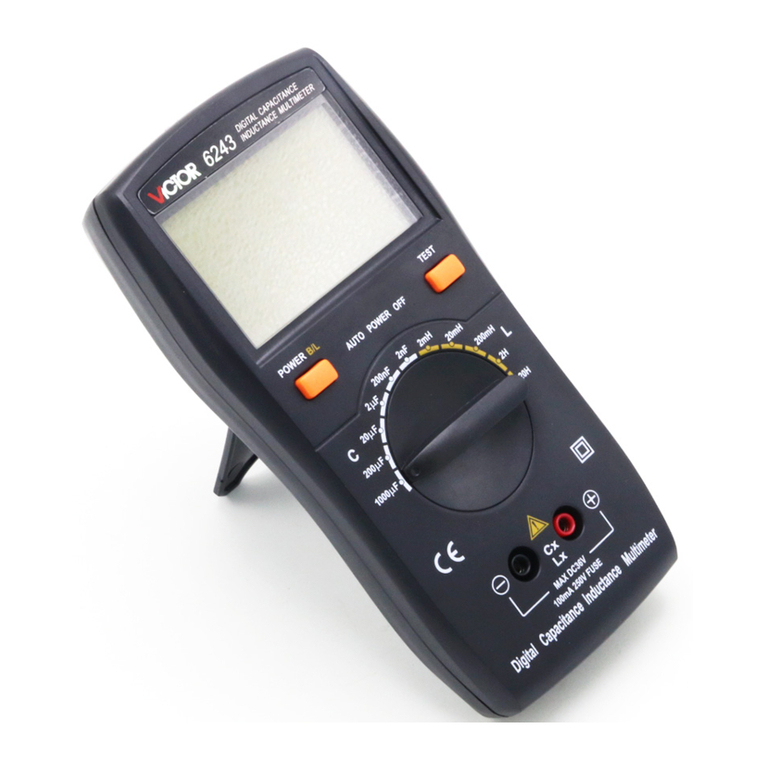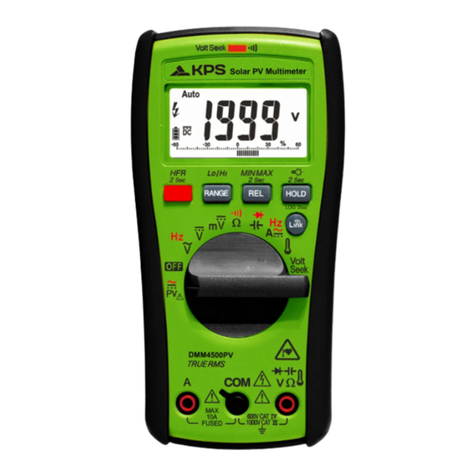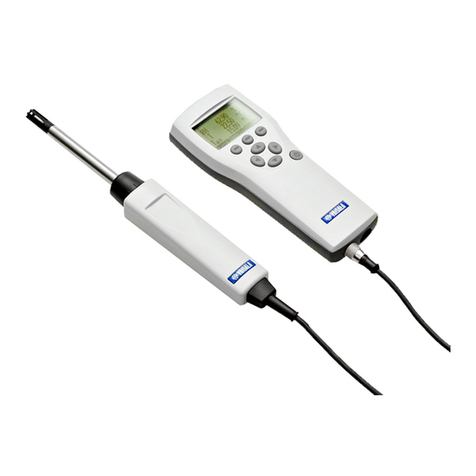SolarEdge SE-MTR240-NN-S-S1 User manual

Installation Guide
Energy Meter with Modbus
Connection
For North America
Version 1.3

Disclaimers
Important Notice
Copyright © SolarEdge Inc. All rights reserved.
No part of this document may be reproduced, stored in a retrieval system or
transmitted, in any form or by any means, electronic, mechanical, photographic,
magnetic or otherwise, without the prior written permission of SolarEdge Inc.
The material furnished in this document is believed to be accurate and reliable.
However, SolarEdge assumes no responsibility for the use of this material. SolarEdge
reserves the right to make changes to the material at any time and without notice. You
may refer to the SolarEdge web site (https://www.solaredge.com/us/) for the most
updated version.
All company and brand products and service names are trademarks or registered
trademarks of their respective holders.
Patent marking notice: see https://www.solaredge.com/us/patent
The general terms and conditions of delivery of SolarEdge shall apply.
The content of these documents is continually reviewed and amended, where
necessary. However, discrepancies cannot be excluded. No guarantee is made for the
completeness of these documents.
The images contained in this document are for illustrative purposes only and may vary
depending on product models.
FCC Compliance
This equipment has been tested and found to comply with the limits for a Class B digital
device, pursuant to part 15 of the FCC Rules.
These limits are designed to provide reasonable protection against harmful interference
in a residential installation. This equipment generates, uses and can radiate radio
frequency energy and, if not installed and used in accordance with the instructions,
may cause harmful interference to radio communications. However, there is no
guarantee that interference will not occur in a particular installation. If this equipment
does cause harmful interference to radio or television reception, which can be
determined by turning the equipment off and on, you are encouraged to try to correct
the interference by one or more of the following measures:
Reorient or relocate the receiving antenna.
Increase the separation between the equipment and the receiver.
Disclaimers 1
Energy Meter with Modbus Connection MAN-01-00270-1.3

Connect the equipment into an outlet on a circuit different from that to which the
receiver is connected.
Consult the dealer or an experienced radio/TV technician for help.
Changes or modifications not expressly approved by the party responsible for
compliance may void the user’s authority to operate the equipment.
Energy Meter with Modbus Connection MAN-01-00270-1.3
2 FCC Compliance

Version History
Version 1.3 (August 2019)
Added notation of default DIP switch settings
Added label to meter showing CTconnections
Corrected description of LEDindicators
Version 1.2 (February 2019)
Meter uses Wye topology configuration.
Version 1.1 (January 2019)
Updated for new meter hardware
Addition of configuration via SetApp
Version 1.0 (April 2017) - Initial release
Version History 3
Energy Meter with Modbus Connection MAN-01-00270-1.3

Contents
Disclaimers 1
Important Notice 1
FCC Compliance 1
Version History 3
Contents 4
HANDLING AND SAFETY INSTRUCTIONS 5
Safety Symbols Information 5
Chapter 1: Introduction 6
Terminology 6
The SolarEdge Energy Meter with ModbusConnection 6
Meter Interfaces 7
Meter Connection 9
Meter Connection Options 10
Chapter 2: Meter Installation 12
Transport and Storage 12
Package Contents 12
Installation Equipment 12
Installation Guidelines 12
Installing and Connecting the Meter 13
Chapter 3: Configuration 21
Device Configuration 21
Appendix A: Troubleshooting the Meter 29
Troubleshooting the Meter using SetApp 29
Troubleshooting the Meter using the Device Display 32
Appendix B: Installing Two Meters 35
Connecting Two Meters 35
Configuring the Dual-Meter Connection 35
Verifying the Meter Connection 37
Troubleshooting the Dual-Meter Connection 39
Appendix C: Monitoring Platform - Meter Data 42
Appendix D: External Lightning Protection 43
Appendix E: Energy Meter with Modbus Connection Technical Specifications 44
Support Contact Information 45
Energy Meter with Modbus Connection MAN-01-00270-1.3
4 Contents

HANDLING AND SAFETY INSTRUCTIONS
During installation, testing and inspection, adherence to all the handling and safety
instructions is mandatory. Failure to do so may result in injury or loss of life and
damage to the equipment.
Safety Symbols Information
The following safety symbols are used in this document. Familiarize yourself with the
symbols and their meaning before installing or operating the system.
WARNING!
Denotes a hazard. It calls attention to a procedure that, if not correctly
performed or adhered to, could result in injury or loss of life. Do not proceed
beyond a warning note until the indicated conditions are fully understood and
met.
AVERTISSEMENT!
Dénote un risque: il attire l'attention sur une opération qui, si elle n'est pas faite
ou suivi correctement, pourrait causer des blessures ou un danger de mort. Ne
pas dépasser une telle note avant que les conditions requises soient
totallement comprises et accomplies.
CAUTION!
Denotes a hazard. It calls attention to a procedure that, if not correctly
performed or adhered to, could result in damage or destruction of the
product. Do not proceed beyond a caution sign until the indicated conditions
are fully understood and met.
ATTENTION!
Dénote un risque: il attire l'attention sur une opération qui, si elle n'est pas faite
ou suivi correctement, pourrait causer un dommage ou destruction de
l'équipement. Ne pas dépasser une telle note avant que les conditions requises
soient totallement comprises et accomplies.
NOTE
Denotes additional information about the current subject.
IMPORTANTSAFETYFEATURE
Denotes information about safety issues.
HANDLING AND SAFETY INSTRUCTIONS 5
Energy Meter with Modbus Connection MAN-01-00270-1.3

Chapter 1: Introduction
Terminology
The following terms are used in this document:
Export: The power injected to the grid.
Import: The power purchased from the grid.
Export/Import meter: A meter that is installed at the grid connection point and
measures the energy/power exported/imported to/from the grid.
Consumption: The power consumed by the site.
Consumption meter: A meter that is installed at the load consumption point and
measures the energy/power consumed by the site.
Self-consumption: The PVpower consumed by the site and not fed into the grid.
Production: The power produced by the PV system.
Production meter: A meter that is installed at the inverter output or site AC
connection, or in the inverter (a built-in revenue grade meter), and measures the
energy/power produced by the PVsystem or site.
Figure 1: Terminology Illustration
Three-phase grid configuration types:
Wye: In a Wye ("Y") configuration, all three phases are connected at a single neutral
point. Wye systems utilize five wires - three hot, one neutral and one ground.
Delta: In a Delta configuration, the three phases are connected in a triangle. Delta
systems utilize four wires - three hot and one ground.
The SolarEdge Energy Meter with ModbusConnection
The SolarEdge Energy Meter with ModbusConnection (also referred to as “the meter”)
enables measuring the power and energy of the photovoltaic (PV)system.
Energy Meter with Modbus Connection MAN-01-00270-1.3
6 Chapter 1: Introduction

The meter is used by the inverter for the following applications:
Production metering
Consumption monitoring
Export limitation
Smart Energy on-grid applications
The meter is built into an enclosure and requires
two Current Transformers
(CTs). The
CTs are available from SolarEdge.
Meter Interfaces
This section describes the meter's external and internal interfaces.
External Interfaces
Drill guides for AC: used to feed the meter power supply as described in
Installing
and Connecting the Meter
on page 13.
Additional drill guides: provide additional cabling entry points in the meter
enclosure as required
Internal Interfaces
Figure 2: Meter interfaces
Voltage connections (L1, L2,N, Ground): for connection to the grid
CTconnections (L1 CT, L2 CT): for connection to current transformers
RS485: for connection to the inverter/gateway
LEDs: used to monitor meter status.
Chapter 1: Introduction 7
Energy Meter with Modbus Connection MAN-01-00270-1.3

ID DIPswitches (ID 1, 2, 3): used to set the Modbus address.
Termination DIPswitches (TERM 1, 2): used to set RS485 termination.
LEDs
The meter utilizes the LEDs at the top of the unit in order to indicate current status.
Figure 3: Meter LED
LED # LED Function Indication
1Bottom -
green Status Flashing ON/OFF - normal operation
2Middle -
yellow
RS485 Modbus
communication Flashing ON/OFF - communication OK
3Top -
yellow Energy management Turns ON when the meter reads an energy
change of ~1 kwH. Then turns OFF.
ID DIPswitches
The IDDIPswitches are used to set the Modbus address of the meter. The addressing
options are listed in the table below.See the figure
ID and Termination DIP Switches
on
page 9 for switch direction guidelines.
Modbus Address ID 1 ID 2 ID 3
0 Down Down Down
1 Up Down Down
2 (factory default) Down Up Down
3 Up Up Down
4 Down Down Up
Energy Meter with Modbus Connection MAN-01-00270-1.3
8 Meter Interfaces

Modbus Address ID 1 ID 2 ID 3
5 Up Down Up
6Down Up Up
7 Up Up Up
Termination DIPswitches
The Termination DIPswitches are used to configure RS485 wiring termination. The
termination options are listed in the table below. See the figure
ID and Termination DIP
Switches
on page 9 for switch direction guidelines.
RS485 Termination TERM 1 TERM 2
Terminated (factory default) N/A Down
Not Terminated N/A Up
Figure 4: ID and Termination DIP Switches
Meter Connection
The SolarEdge inverter or the Commercial Gateway reads the exported/imported power
from a meter installed at the grid connection point or reads the consumption from a
meter installed at the load consumption point.
Chapter 1: Introduction 9
Energy Meter with Modbus Connection MAN-01-00270-1.3

Figure 5: Typical installation with production meter
Figure 6: Typical installation with export/import meter
Figure 7: Typical installation with consumption meter
Meter Connection Options
In a
single
inverter system, the meter is connected directly to the inverter. If your
inverter has a built-in revenue grade meter (RGM; the inverter is referred to as a revenue
grade inverter), you can connect an external meter on the same bus as the RGM
(available from SolarEdge).
Energy Meter with Modbus Connection MAN-01-00270-1.3
10 Meter Connection Options

Figure 8: Single-inverter connection
In a
multiple
inverter system, the meter is connected to the RS485 port of one of the
inverters. If the inverter has only one RS485 bus, use an RS485 Plug-in (available from
SolarEdge) or wireless communications between the inverters.
Chapter 1: Introduction 11
Energy Meter with Modbus Connection MAN-01-00270-1.3

Chapter 2: Meter Installation
Transport and Storage
Transport the Energy Meter with Modbus Connection in its original packaging, without
exposing it to unnecessary shocks. If the original package is no longer available, use a
similar box that can be closed fully.
Store the meter in a dry place where ambient temperatures are -40°C / -40°F to +60°C /
140°F.
Package Contents
Meter
Mounting bracket
Accessories kit
Installation guide
Installation Equipment
Standard tools can be used during the installation of the meter. The following is a
recommendation of the equipment needed for installation:
Drill and 5/32 inch diameter bits
Installation Guidelines
AC wire specifications:
1.3 to 2.0 mm diameter / 16-12 AWG stranded wire, 600 V, type THHN, MTW, or
THWN.
RS485 wiring specifications:
Cable type: Min. 3-wire shielded twisted pair (a 4-wire cable may be used)
Wire cross-section area: 0.2- 1 mm²/ 24-18 AWG (a CAT5 cable may be used)
NOTE
If using a cable longer than 10 m/33 ft in areas where there is a risk of induced
voltage surges by lightning, it is recommend to use external surge protection
devices. For details refer to
External Lightning Protection
on page 43. If
grounded metal conduit are used for routing the communication wires, there
is no need for a lightning protection device.
Additional guidelines:
Energy Meter with Modbus Connection MAN-01-00270-1.3
12 Chapter 2: Meter Installation

The meter is considered “permanently connected equipment” and requires a
disconnect means (circuit breaker, switch, or disconnect) and overcurrent
protection (fuse or circuit breaker).
The meter draws up to 100 mA, therefore the rating of any switches, disconnects,
fuses, and/ or circuit breakers is determined by the wire gauge, the mains voltage,
and the current interrupting rating required.
The switch, disconnect, or circuit breaker must be located near the meter and be
easily operated .
Use circuit breakers or fuses rated for 20A or less.
Use grouped circuit breakers when monitoring more than one line.
The circuit breakers or fuses must protect the mains terminals labeled L1, and L2. In
the rare cases where neutral has overcurrent protection, the overcurrent protection
device must interrupt both neutral and the ungrounded conductors simultaneously.
The circuit protection / disconnect system must meet all national and local
electrical codes.
Installing and Connecting the Meter
Mount the meter on a wall or pole using the supplied bracket.
The meter should be mounted vertically, with the glands facing downward.
To mount the meter:
1. Loosen the 4 Allen screws of the enclosure and remove the cover.
Figure 9: Meter cover screws
2. Open one of the the
bottom
conduit drill guides for ACwiring (see
Figure 6
below),
taking care not to interfere with any of the internal components. A Unibit drill may
Chapter 2: Meter Installation 13
Energy Meter with Modbus Connection MAN-01-00270-1.3

be used. The rest of the drill guides (located at the bottom, back and sides of the
enclosure, each with two sizes: ¾'' and 1'') should remain sealed.
Figure 10: AC wiring drill guide
3. Install the bracket on a wall or pole, with the semi-circles facing downward, as
shown below. Verify that the bracket is firmly attached to the mounting surface.
Figure 11: Mounting bracket
4. Mount the meter: Attach the enclosure back brackets to the mounted bracket using
the four supplied screws. Tighten the screws with a torque of 9 N*m / 6.6 lb*ft.
Figure 12: Back brackets
5. Open one or more conduit drill guides as required for the installation - each with
two sizes: ¾'' and 1'', taking care not to interfere with any of the internal
components. A Unibit drill may be used.
CAUTION!
Use only drill guides located at the bottom, back and sides of the
enclosure. Opening the top drill guides may damage the protection rating
of the enclosure.
Energy Meter with Modbus Connection MAN-01-00270-1.3
14 Installing and Connecting the Meter

Figure 13: Meter - rear view
6. Mount the meter: Attach the meter enclosure's back brackets to the mounted
bracket using the four supplied screws. Tighten the screws with a torque of 9 N*m /
6.6 lb*ft.
To install the current transformers (CTs):
CAUTION!
NOTE
CTs are not supplied with the meter and must be purchased separately.
Rogowski coils are
not
suitable for use with the meter.
1. Turn off AC power before clamping on current transformers.
2. Install the CTs around the conductor to be measured. Split-core CTs can be opened
for installation around a conductor. A nylon cable tie may be secured around the CT
to prevent accidental opening.
3. Install the CTs with the arrows pointing to the grid for consumption or export
measurement.
Chapter 2: Meter Installation 15
Energy Meter with Modbus Connection MAN-01-00270-1.3

To wire the meter:
Wire the meter in accordance with one of the connection diagrams below:
Split phase grid, see the figure
Split Phase Grid
on page 16
No-neutral grid, see the figure
No-Neutral Grid
on page 17
If you are connecting the meter to a
revenue grade inverter
(inverter with built-in
meter), refer to
Installing Two Meters
on page 35.
Figure 14: Split Phase Grid
NOTE
Clamp the CTconnected to L1 CT around the wire connected to ØL1.
Clamp the CTconnected to L2 CT around the wire connected to ØL2.
When clamping the CT around the conductor to be measured, make sure the
arrow is pointing towards the grid.
Energy Meter with Modbus Connection MAN-01-00270-1.3
16 Installing and Connecting the Meter

Figure 15: No-Neutral Grid
NOTE
Clamp the CTconnected to L1 CT around the wire connected to ØL1.
When clamping the CT around the conductor to be measured, make sure the
arrow is pointing towards the grid.
1. Verify that the meter is powered OFFbefore making connections.
2. Insert the grounding/neutral cable, AC-side wires, CT wires, and RS485 cabling
through the drill guide(s) that were opened and connect them to the meter as
specified in the above diagrams.
3. Verify that the meter's termination DIP switches are set for "termination", as
specified in the section "Termination DIPswitches" on page9.
4. Connect the RS485 wiring to the inverter or Commercial Gateway.
To wire the inverter, see the procedure "connect the RS485 wiring to the
inverter:" below
To wire the Commercial Gateway, see the procedure "connect the RS485 wiring
to the Commercial Gateway:" on page19.
To connect the RS485 wiring to the inverter:
1. Remove the seal from one of the openings in communication gland #2 at the
bottom of the inverter and insert the RS485 wires from the meter through the
opening.
Chapter 2: Meter Installation 17
Energy Meter with Modbus Connection MAN-01-00270-1.3

2. Prepare to connect the RS485 wiring to one of the available RS485 ports of the
device. Note that some inverters have one RS485 port, some have two RS485 ports.
3. Pull out the RS485 connector located on the communication board, as shown in the
figure below.
Figure 16: Inverter RS485 connection
4. Loosen the screws of RS485 terminal block pins B, A and G of the port you wish to
connect.
Figure 17: RS485 terminal block
5. Insert the wire ends into the G, A and B pins shown above. Use Four- or six-wire
twisted pair cable for this connection.
You can use any color wire for each of the A, B and G connections, as long as:
The same color wire is used for all A pins the same color for all B pins and the
same color for all G pins
The wire for G is not from the same twisted pair as A or B.
6. Tighten the terminal block screws.
7. Push the RS485 terminal block firmly all the way into the communication board.
8. If the inverter is at the end of the RS485 bus, terminate by switching a termination
Energy Meter with Modbus Connection MAN-01-00270-1.3
18 Installing and Connecting the Meter

DIP-switch inside the inverter to ON (top position). The switch is located on the
communication board and is marked SW7.
Figure 18: RS485 termination switch
To connect the RS485 wiring to the Commercial Gateway:
1. Connect to one of one of the 3-pin connectors supplied with the Commercial
Gateway to the RS485-2 connection on the Commercial Gateway.
Figure 19: Commercial Gateway RS485 connector
2. If the Commercial Gateway is at the end of the RS485 bus, terminate by switching
the SW2 termnation DIP switch to ON.
Chapter 2: Meter Installation 19
Energy Meter with Modbus Connection MAN-01-00270-1.3
Table of contents
Other SolarEdge Measuring Instrument manuals
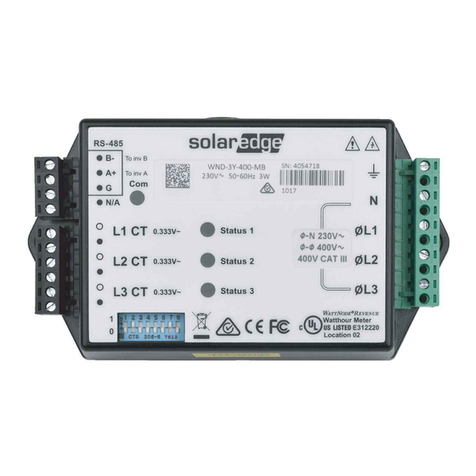
SolarEdge
SolarEdge SE-WND-3Y400-MB-K2 User manual
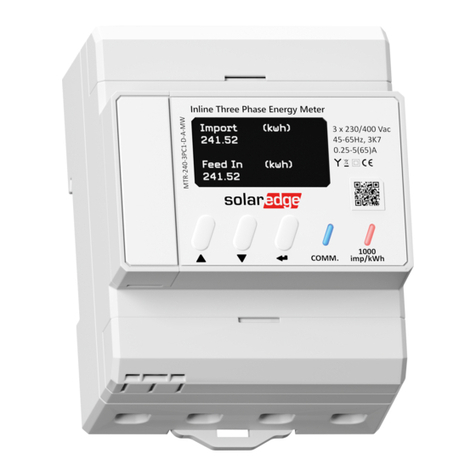
SolarEdge
SolarEdge MTR-240-3PC1-D-A-MW User manual
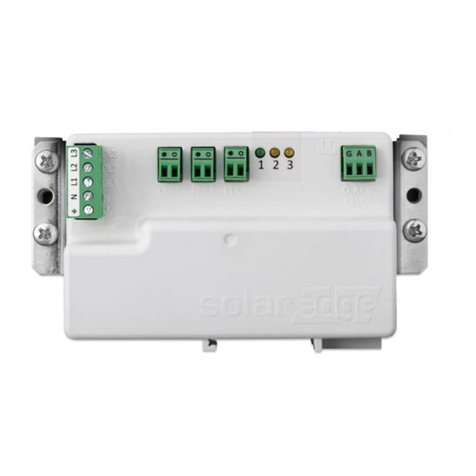
SolarEdge
SolarEdge SE-MTR-3Y-400V-A User manual
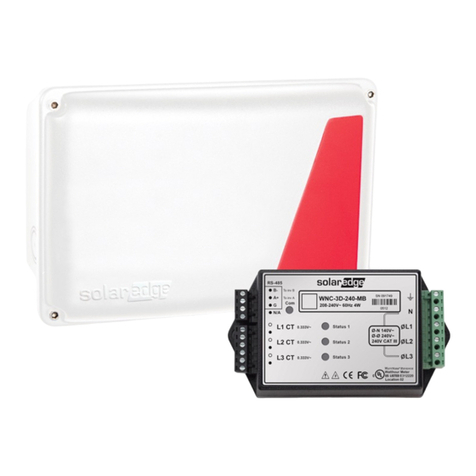
SolarEdge
SolarEdge SolarEdge SE-MTR240-2-400-S1 User manual

SolarEdge
SolarEdge RGM Operating instructions
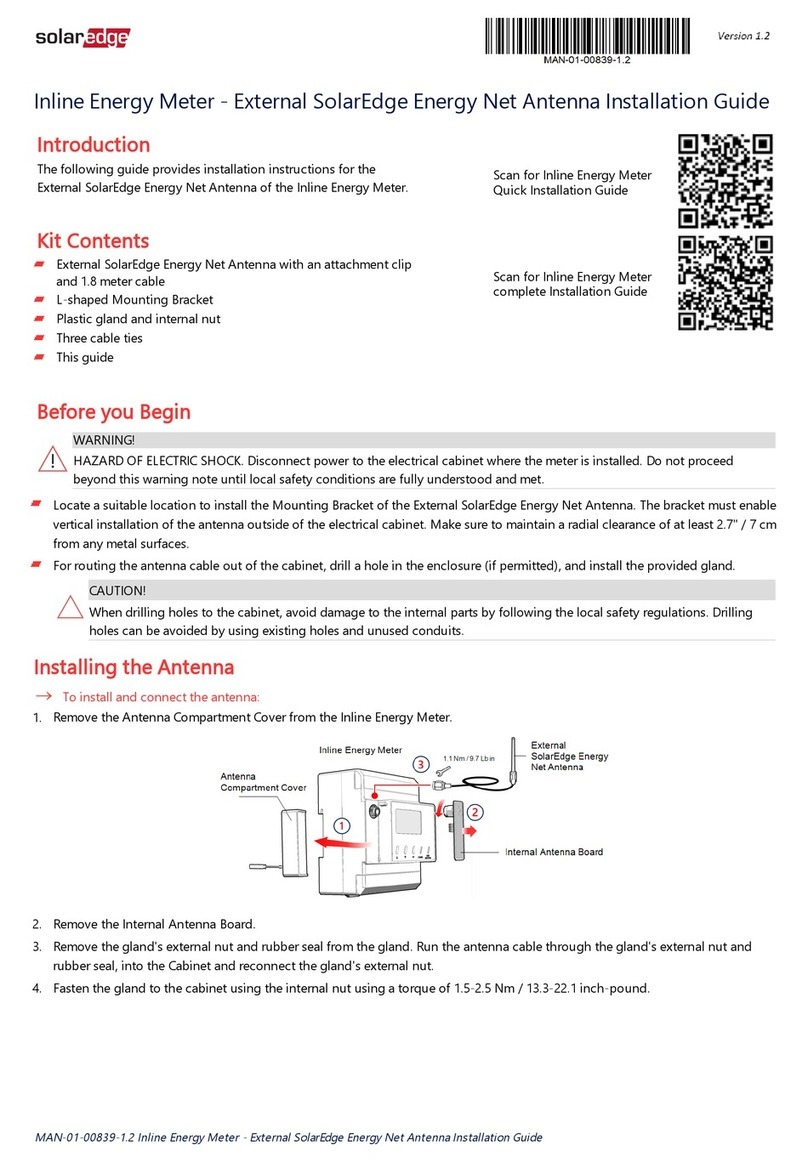
SolarEdge
SolarEdge AS4034-1 User manual

SolarEdge
SolarEdge SE-RGMTR-3D-208V-A User manual

SolarEdge
SolarEdge SE330K Installation and operating instructions
